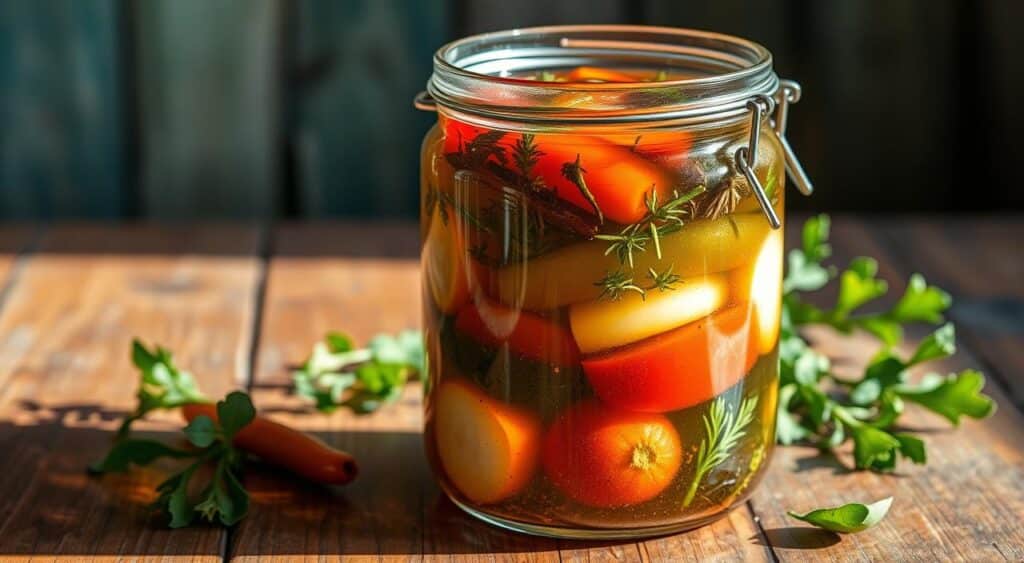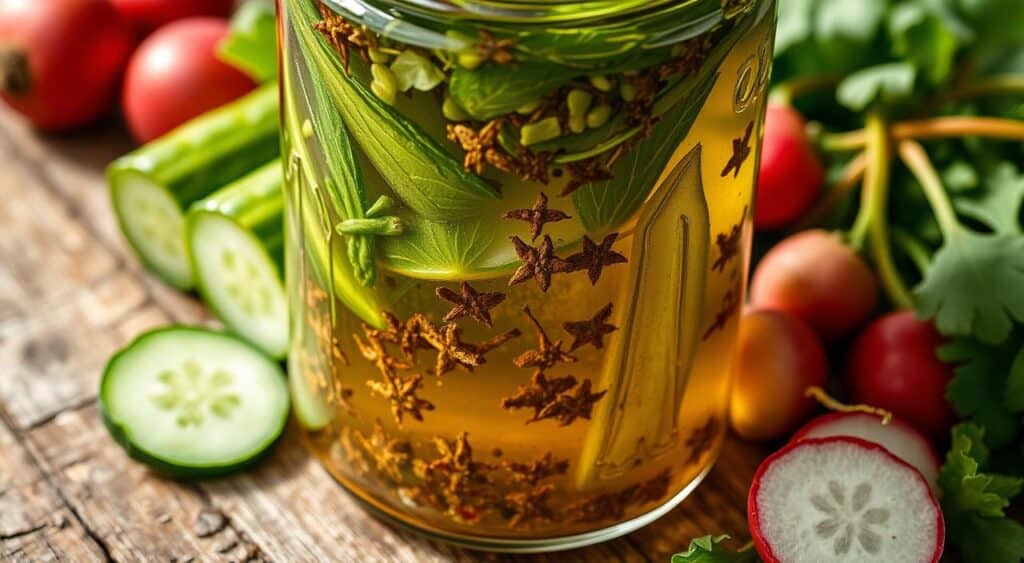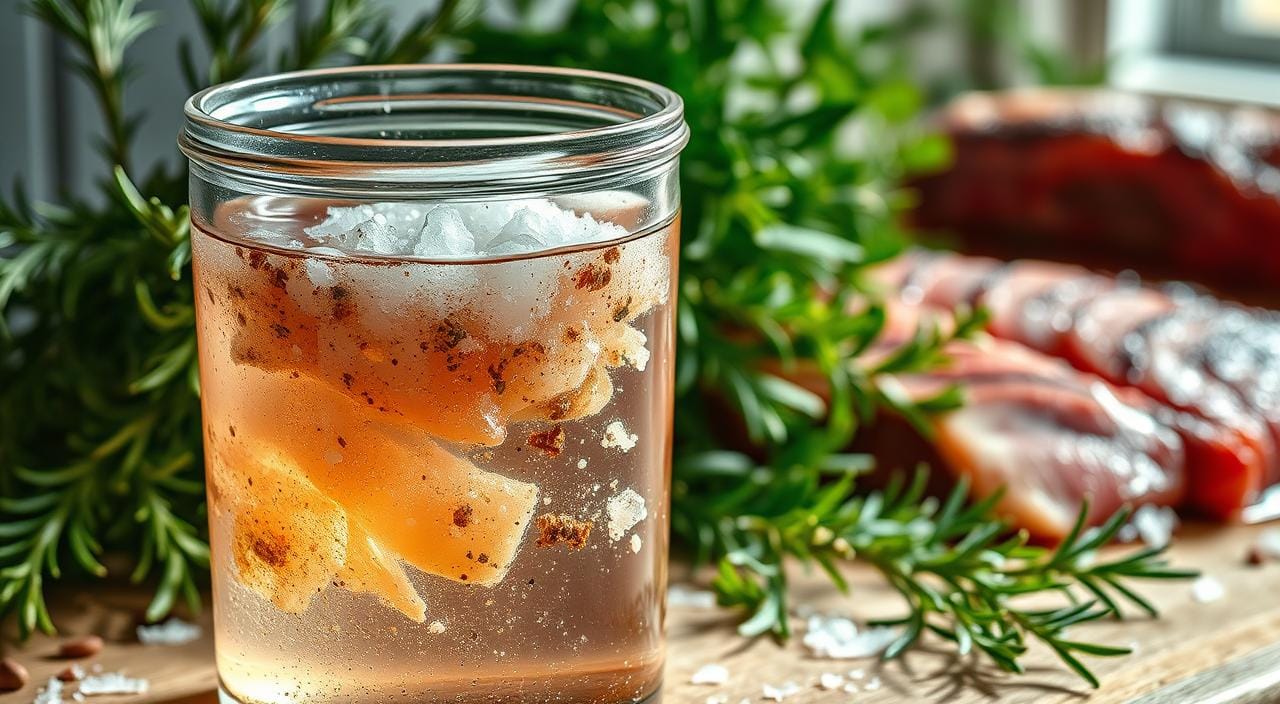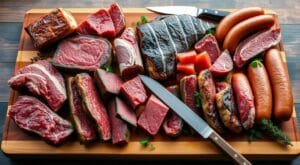Jump to:
Estimated reading time: 13 minutes
Table of contents
How to make brine solution? Brining is a simple kitchen trick. It involves soaking lean meats in a saltwater solution. This makes the meat more moist, tender, and full of flavor.
To make the brine, you mix salt and sometimes sugar, herbs, and spices with water. This mixture gets into the meat. It changes the meat’s texture, making it juicy and full of taste.
This method works great for many cooking ways. You can grill, roast, fry, or smoke the meat. It always turns out tender and delicious.
Key Takeaways
- Brining is a simple technique that involves soaking lean meats in a saltwater solution
- The brine solution penetrates the meat, denaturing the muscle fibers and locking in juiciness
- Brined meats are tender, juicy, and flavorful, perfect for various cooking methods
- The brine solution typically consists of a 10% salt concentration and can be enhanced with optional ingredients
- Proper brining techniques and duration ensure the best results for different types of meat
Introduction
Brining is a simple yet powerful technique that makes lean meats, poultry, and seafood taste amazing. It’s great for making a Thanksgiving turkey, juicy lamb chops, or tender chicken breasts. Learning how to make the perfect brine is a key skill for any cook.
In this guide, we’ll cover the science of brining. We’ll also show you how to make a brine and offer tips for using it with different meats and cooking methods.
Brine solutions are made with 3-6% salt in water. Wet brines are usually around 6% salt, like 2 cups of kosher salt in 1 gallon of water. Dry brining uses 1/2 teaspoon of kosher sea salt for each pound of meat.
Wet brines are best for whole poultry or meat. They should soak for 2 to 24 hours. Dry brining times vary from 30 minutes to several hours, depending on the meat.
“The dry brining process can take between 36-54 hours, and the recommended amount of sea salt for dry brining is 1/2 Teaspoon per pound of meat.”
In the next sections, we’ll dive deeper into brining science. We’ll explore the key ingredients and steps for making the perfect brine. Plus, we’ll share expert tips for using it with different meats and cooking methods.
By mastering brine making, you’ll improve your culinary skills. You’ll create delicious, meat preservation dishes that will wow your family and friends.

What is Brine and Why Use It?
Brine is a saltwater mix used to soak meats, poultry, and seafood before cooking. It’s made by dissolving salt and sometimes other flavors like sugar, herbs, and spices in water. When meat soaks in this brine, it makes the meat tender, juicy, and flavorful.
The Science Behind Brining
Brining changes the meat’s protein structure. The salt in the brine makes proteins unravel, which keeps meat moist and tender. Adding sugar, herbs, and spices can also add extra flavor.
Why Brining Improves Meat Texture and Flavor
Lean meats like chicken and turkey can dry out when cooked. Brining keeps these meats moist and juicy. It also seasons the meat from the inside, making it more flavorful.
How to Make Brine for Different Types of Meat
- For a wet brine, mix 1 cup of kosher salt with 1 gallon of water.
- Plan for 1 hour of brining per pound of meat.
- For a dry brine, use 1/2 teaspoon of kosher salt per pound of meat. Refrigerate for 1 to 2 days.
- Use apple juice as a wet brine for poultry for extra flavor.
- A 12 to 14 pound Thanksgiving turkey should brine overnight, or for 12 to 24 hours.
Getting the brining technique and timing right is key for great results, whether you’re cooking chicken, turkey, beef, or seafood.

Essential Ingredients for Making Brine
To make a flavorful brine, you need to know about its key ingredients. At the heart of any brine are salt and water. They improve the meat’s texture and taste. Salt is the main ingredient, but adding sugar, herbs, and spices can make the brine even better.
How to make brine solution? The Key Ingredient: Salt and Its Role
Choosing the right salt is important for making a brine. Kosher salt is often used because it dissolves well. But, you can also use table salt or other coarse salts. The salt-to-water ratio is usually 1/4 to 1/2 cup of salt per 4 cups of water, depending on the meat.
How to make brine solution? Optional Ingredients: Sugar, Herbs, and Spices
Some recipes add sugar, herbs, and spices to the brine. Sugar balances the saltiness. Herbs and spices, like peppercorns and rosemary, add a complex and aromatic flavor to the meat.
How to make brine solution? Choosing the Right Water-to-Salt Ratio
The salt-to-water ratio is key for the brine’s salinity. A standard ratio is 2 tablespoons of salt per liter of water, making a 3% salt solution. The brine amount needed varies with the meat size. For a whole turkey, use about 1 gallon of brine.

Step-by-Step Guide on How to Make Brine
Making a flavorful brine is key to tender, juicy meat. Follow this easy guide to make your own brine at home. With just a few simple ingredients and some time, you can make your dishes better.
How to make brine solution? Step 1: Measuring the Ingredients Correctly
The right ratio of salt to water is crucial for a good brine. Use 1/4 to 1/2 cup of salt per 1 quart of water for a basic brine. This makes the brine taste like a slightly oversalted soup or seawater.
How to make brine solution? Step 2: Dissolving Salt and Flavors in Water
In a large, non-reactive container, mix the measured salt with optional ingredients like sugar, herbs, or spices. Stir until everything dissolves in the water. This makes sure the brine is evenly seasoned before adding your meat.
How to make brine solution? Step 3: Cooling the Brine Solution Before Use
Chill the brine solution in the fridge before using it. This step is important for keeping the meat safe and preventing bacteria from growing.
By following these steps, you’re on your way to making a perfect brine. Your meat will be moist, tender, and full of flavor. Impress your family and friends with your cooking skills!
Variations of Brine Solution for Different Meats
Brining is a versatile technique that can be tailored for various meats. Whether you’re brining chicken and poultry, beef, fish, or seafood, knowing the right recipe and brining time is key. This ensures your dishes are both flavorful and tender.
How to make brine solution? Brine for Chicken and Poultry
For chicken and poultry, a simple brine of salt, water, and sugar is often used. Brining these meats for 1-2 hours helps them soak up flavors and stay moist. You can also add herbs, spices, or citrus to enhance the taste.
How to make brine solution? Brining Turkey for Tender Juiciness
Turkey needs a longer brine, usually 4-8 hours. This longer soak tenderizes the meat and boosts its juiciness. The brine for turkey might include brown sugar, molasses, or apple cider to balance its flavors.
How to make brine solution? Brine Solutions for Beef, Fish, and Seafood
Beef is rarely brined because of its high fat content and preferred doneness. However, fish and seafood like shrimp and salmon can be brined. Their brine is lighter, preserving their natural flavors.
| Meat | Brine Solution | Brining Time |
|---|---|---|
| Chicken and Poultry | Salt, water, sugar | 1-2 hours |
| Turkey | Salt, water, brown sugar, molasses, apple cider | 4-8 hours |
| Beef | Not typically brined | N/A |
| Fish and Seafood | Salt, water, light seasonings | Varies by type |
Mastering the art of brining different meats can elevate your cooking. It leads to dishes that are not only delicious but also tender and full of flavor. Your family and guests will be impressed.
Common Mistakes When Making Brine
Making brine might seem easy, but there are a few common mistakes. It’s important to get the salt-to-water ratio right, dissolve the salt properly, and avoid over-brining the meat. These steps are key to getting juicy, flavorful results.
Using the Wrong Salt-to-Water Ratio
One big brine mistake is using the wrong salt-to-water ratio. Too much salt makes the brine too salty, leading to dry meat. Too little salt means the meat won’t taste good and might be bland. The perfect ratio is about 1/4 cup of salt per quart of water, similar to seawater’s salinity.
Not Dissolving Salt Properly
Another brine mistake is not fully dissolving the salt in the water. If the salt doesn’t dissolve fully, the brine won’t work right. The salt needs to be fully dissolved for the brine to season the meat evenly.
Brining Meat for Too Long
Finally, over-brining the meat is a big mistake. While longer brining times can add moisture and flavor, too long can make the meat too salty and soggy. A good rule of thumb is to brine for about 1 hour per pound of meat.
By avoiding these common brine mistakes, you can make sure your meats are always juicy, flavorful, and perfectly seasoned.
How to Make Brine for Specific Cooking Methods
Brining is great for many cooking ways, like grilling, roasting, frying, and smoking. It keeps meat moist and adds flavor. This makes the meat juicier and more tasty.
How to make brine solution? Brining for Grilling and Roasting
Brining is key for grilled or roasted meats. It keeps them moist and brings out their natural taste. The salt in the brine seasons the meat from the inside.
This makes the meat tender and juicy, even with lean cuts. It also helps create a nice crust when searing or grilling.
How to make brine solution? Brining for Frying or Smoking Meat
Brining is also good for frying or smoking meats. It helps make the outside crispy and lets smoke flavors in better. The salt in the brine makes the meat drier, leading to a crisper finish when fried.
For smoked meats, the brine helps absorb smoke flavors. This adds depth and complexity to the dish.
How to make brine solution? Using Brine for Sous Vide Cooking
In sous vide cooking, brining seasons the meat and keeps it juicy. The brine infuses the meat with flavor. The sous vide method keeps the meat moist and tender.
Adjust the brine recipe and brining time based on your cooking method and goals. Try different brines and techniques to enhance your meats. This works for grilling, roasting, frying, smoking, or sous vide.
Nutritional Considerations of Brining
Brining can make meat taste better and feel juicier. But, it can also increase sodium levels. The salt in the brine gets absorbed by the meat, adding more sodium in brined meat per serving. To keep sodium levels down, try using low-sodium alternatives like sea salt or kosher salt. You can also add citrus juices or vinegars to the brine.
Brining with natural ingredients like herbs, spices, and unrefined sugars can also boost nutrition. This method not only makes the meat taste better but also offers a healthier option compared to traditional brining.
Sodium Levels in Brined Meat
The salt content in the brine recipe is 6.6%. Brined meats can soak up about 10% of their weight in brine. This results in around 3.25 grams of salt, or 1300mg of sodium per pound of meat. Interestingly, chicken absorbs more brine compared to tukey, with chicken taking up to 1,673mg of sodium per pound.
Using Low-Sodium Alternatives in Brine
To cut down on sodium in brined meat, use low-sodium alternatives like sea salt or kosher salt. These salts have less sodium but also add minerals and trace elements that are good for health.
Nutritional Benefits of Brining with Natural Ingredients
Brining with natural ingredients like herbs, spices, and unrefined sugars does more than just enhance flavor. These ingredients add antioxidants, vitamins, and minerals, making the meat a healthier choice.
| Brine Ingredient | Nutritional Benefits |
|---|---|
| Herbs (e.g., rosemary, thyme, sage) | Rich in antioxidants, anti-inflammatory properties, and essential oils |
| Spices (e.g., black pepper, garlic, onion) | Contain various vitamins, minerals, and phytochemicals |
| Unrefined Sugars (e.g., honey, maple syrup) | Provide natural sweetness and contain trace minerals |
“Brining with natural, whole-food ingredients can provide additional nutritional benefits beyond just improving the meat’s taste and texture.”
FAQ: How to make brine solution?
Brining turns ordinary meats into tender, tasty treats. You might have questions as you start brining. Let’s answer the most common ones about making great brine.
What is the Ideal Salt-to-Water Ratio for Brining?
The salt-to-water ratio for brine is usually 3-6% by weight. A common mix is 2 cups of kosher salt for every 1 gallon of water. Or, you can use 1 cup of fine sea salt for the same amount of water. This mix helps the meat soak up moisture and flavor, making it juicy and flavorful.
How Much Brine Do I Need?
The brine amount depends on the meat’s size. Generally, 1 gallon of brine covers up to a 14-lb turkey. For dry brining, use about 1/2 teaspoon of kosher sea salt per pound of meat.
How Long Should I Brine the Meat?
Brining times vary, from 15 minutes for fish to 24 hours for a turkey. Poultry and turkey usually brine for 4-24 hours. Steak dry brining takes 30 minutes to 2 hours.
Can I Use Hard Water for Brining?
Hard water can mess with brining, as minerals can block salt and flavor absorption. Use filtered or distilled water for best results. If your water is hard, consider using a water softener or test strips to check its hardness.
What are Some Brining Ratio Guidelines?
For brining up to 14 hours, use 1/2 cup of Morton Coarse Kosher Salt for every 1 gallon of water. For 4-5 hour brining, use 1 cup of Morton Coarse Kosher Salt for the same amount of water.
Brining is all about experimenting to find the right flavor and texture. Enjoy your brining adventures!
Conclusion: Mastering the Art of Making Brine for Delicious, Tender Meat
Learning to make the perfect brine is a skill that can make your meat dishes better. It’s about knowing the science, picking the right ingredients, and using the right techniques. This way, you can make meats that are juicy, tender, and full of flavor.
Brining is key to making meat taste great. It breaks down muscle fibers, adds moisture, and boosts flavor. By trying different salt levels and adding herbs, spices, and sugars, you can make a brine that’s just right for your meat and cooking method.
Now you know how to brine with confidence. Enjoy the benefits of brine for delicious meat and brine for tender meat. Let your cooking skills shine by mastering the brine. Your meals will be even better.






